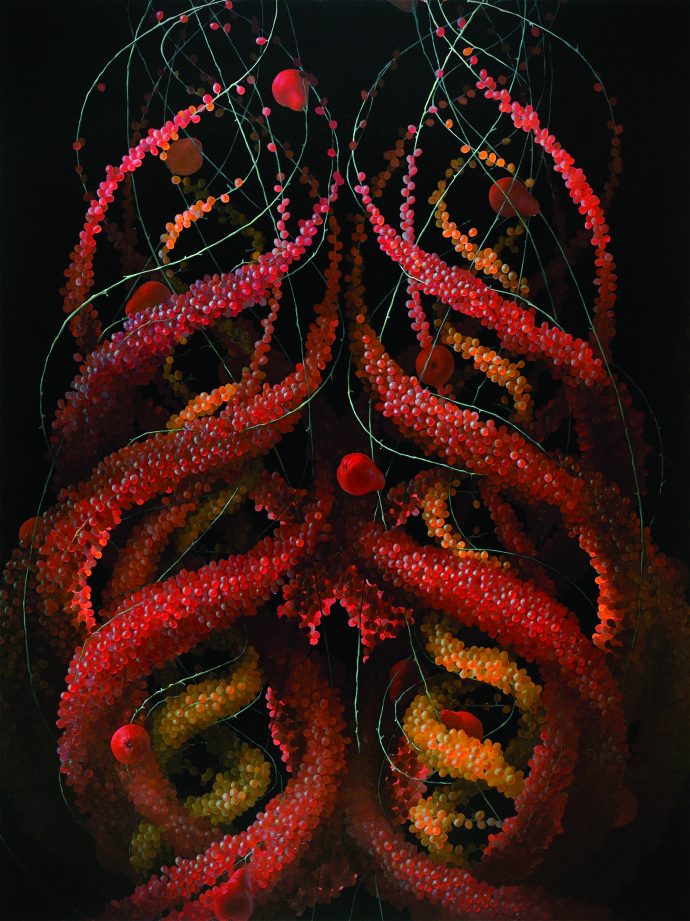Few genres are more popular with artists than the still life – for obvious reasons. When you’re starting out, struggling to master your craft and make ends meet, half a cantaloupe is not going to demand a model’s fee or get huffy if you ask for a certain pose. Nor is a peach going to exclaim, “You made me look fat.”
But the still life engages even the most successful of artists, because it offers challenges to painterly technique as well as a richness of iconography. Small wonder, then, that the still life has been with us since ancient times and continues to resonate today.
You gotta hand it to the ancient Egyptians, who believed you definitely can take it with you. Their depictions of succulent foods on tomb walls held the hope that these would become real in the afterlife to nourish the deceased. Their Greek counterparts were more interested in the craft of painting objects; the Romans, in using paintings of objects as a way to welcome people into their homes.
Throughout the Middle Ages and the Renaissance, the still life was considered a less important genre than religious (Christian) painting and ultimately, history painting – a term that would come to embrace religious works, with Jesus as the central figure in Western art, as well as allegorical, mythological and actual historical subjects. Indeed, the still life would never be the most important genre, particularly in the art of southern Europe, which is one of the reasons that women could excel in it. Since they had no access to art academies – and the nude figures that were key to artistic training – women had to content themselves with painting flowers and bowls of fruit.
But two things would happen in northern Europe during the Renaissance that would elevate the humbly domestic still life. One was the development of oil painting, which enabled artists like Jan van Eyck to depict objects with almost photographic clarity, thanks to the use of slow-drying pigments that could be mixed and layered. The other was the blending of Christian iconography with everyday objects. Half a millennium later, Freud would famously remark that sometimes, a cigar is just a cigar. But in the northern Renaissance and Baroque, a bowl of fruit became anything but a mere bowl of fruit.
Nowhere is this more dramatically conveyed than in the vanitas paintings, so named for the quote from Ecclesiastes 1:2: “Vanity of vanities… all is vanity.” These works would contain symbols of the good life – a globe for travel and conquest, musical and writing instruments for accomplishment and entertainment, flowers, food and wine. But not so hidden among them would be a skull, an hourglass or another memento mori – or reminder that the things of this world are fleeting. So we had best be about the business of our immortal souls. (Note that the term “still life” is a translation from the German. In the Romance languages, the term translates as “dead nature.”)
You didn’t need a skull or hourglass in a still life, though, to remind you of this. Sometimes the half-eaten or rotting food or a dead animal would do the trick. Even a still life burgeoning with food might be less an invitation to indulge than a warning about the moral consequences of overindulgence.
The 18th century said, “To hell with all that.” The rational Rococo saw the still life as decorative, with flowers better suited to the task than food. (Although there were some ravishing still lifes by the mid-18th century’s Jean-Baptiste-Siméon Chardin and Anne Vallayer-Coster.) With the apotheosis of the history painting and its central figure, the male nude, at the turn of the 19th century, the still life was virtually eclipsed.
But if you wait long enough, a trend always returns with the tide. The rise of the bourgeoisie and the use of interior scenes in the Realist, Impressionist and Postimpressionist movements brought renewed interest in the still life. The artists of the 19th and 20th centuries gave the still life color and vigor even as Pablo Picasso and the other Cubists sought to deconstruct its elements at the 20th century’s dawn.
In that century – which was in many ways a summation of the ending millennium – the still life and/or its elements became sculptural (Marcel Duchamp), sexual (Georgia O’Keeffe, Edward Weston) and 3-D (Jasper Johns); went native (Frida Kahlo) or Pop (Andy Warhol); or mixed things up (Roy Lichtenstein).
Today the still life has gone the way of all flesh – becoming digitized and Photoshopped. Yet its iconographic power remains intact. The work of New Rochelle-based Mia Brownell (WAG, August, 2011), who teaches drawing and painting at Southern Connecticut State University in New Haven, melds the luscious realism of the Old Masters with commentary on the environmental and biological sciences. (She is the daughter of a sculptor and a biophysicist.)
The still life hasn’t lost its punch. We’re still taking a bite out of its apples.





